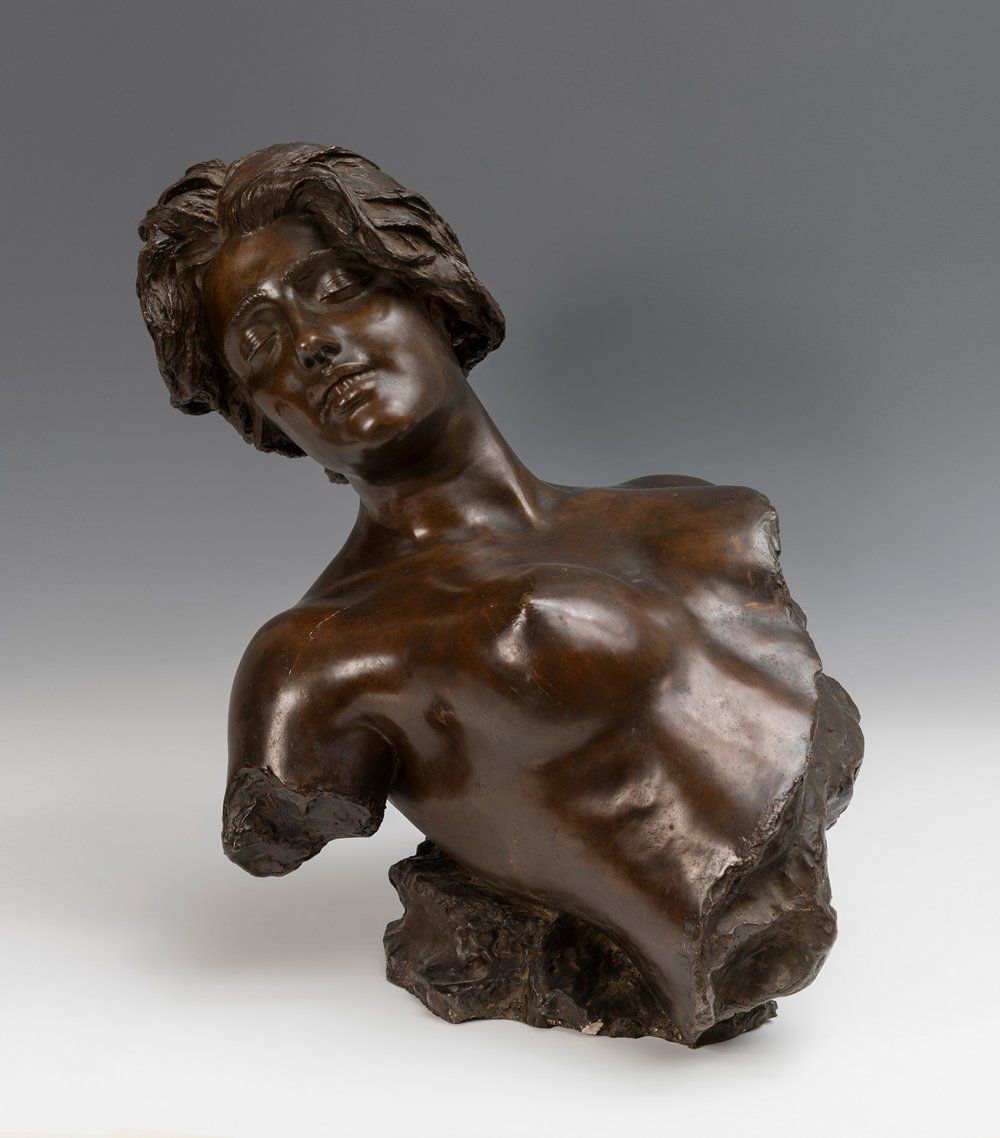Description
Giuseppe RENDA (Polistena, 1859 - Napoli, 1939). "Extasis". Bronze. Measurements: 58 x 50 x 47 cm. Giuseppe Renda began to approach sculpture working in the workshop of the Morani brothers. In 1874 he moved to Naples, and later began to study at the Academy of Fine Arts. There he was a pupil of Tommaso Solari, Stanislao Lista and Gioacchino Toma. At the academy he won the competition to enter the Royal Institute of Fine Arts in Naples, and began working in the ceramics factory of Cacciapuoti and Scotti in Capodimonte, as a modeller of shepherds and figures. In 1898 he was appointed technical director of the Laganà foundry in Naples. His national exhibitions were held in Palermo in 1891 with Angelo caduto and Cosi mi ami, in Milan in 1894 with La Fortuna, in Florence in 1896 with Prima ebbrezza, in Turin in 1898 with Voluttà and in Verona in 1900 with Ondina. He also participated in numerous international exhibitions in London, St. Petersburg, Barcelona and Vienna, receiving two gold medals, with Prima ebbrezza (in 1896 in Munich) and with Dopo (in 1904 in Saint-Louis). He was awarded Monelli napoletani in 1909 in Paris. Giuseppe Renda took part in the exhibitions of the Società Promotrice di Belle Arti 'Salvator Rosa', and in the first national exhibitions. He was the author of important monuments, including those of General Enrico Cosenz, Giacomo Leopardi and the bust of Tommaso Campanella in Chiaia. Monumenti ai caduti di Pazzano, Castellammare di Stabia and Tropea, his sculptures were in demand all over the world, his success lay in his figures, with new elements borrowed from the Art Nouveau style, such as Donna sorridente 1915, Prima ebbrezza 1895. He also created nativity scenes in clay, and his works in bronze are also numerous, among them: Bronzetto Estasi (Ecstasy), Bronzetto Violeta 1908, small bronzes in Reggio Calabria, the Bronzo Dopo (After the Bronze) and La Fortuna (Fortune) seven metres high, whose original in marble is housed, together with other works donated by his heirs, at the headquarters of the Polistena branch of the Banca Monte dei Paschi di Siena (formerly Banca Popolare di Polistena). Following an agreement between Monte Paschi di Siena and the municipality of Renda's hometown, a bronze copy of "La Fortuna" will be exhibited in Piazzale Bellavista and will be freely available to the public.
33
Giuseppe RENDA (Polistena, 1859 - Napoli, 1939). "Extasis". Bronze. Measurements: 58 x 50 x 47 cm. Giuseppe Renda began to approach sculpture working in the workshop of the Morani brothers. In 1874 he moved to Naples, and later began to study at the Academy of Fine Arts. There he was a pupil of Tommaso Solari, Stanislao Lista and Gioacchino Toma. At the academy he won the competition to enter the Royal Institute of Fine Arts in Naples, and began working in the ceramics factory of Cacciapuoti and Scotti in Capodimonte, as a modeller of shepherds and figures. In 1898 he was appointed technical director of the Laganà foundry in Naples. His national exhibitions were held in Palermo in 1891 with Angelo caduto and Cosi mi ami, in Milan in 1894 with La Fortuna, in Florence in 1896 with Prima ebbrezza, in Turin in 1898 with Voluttà and in Verona in 1900 with Ondina. He also participated in numerous international exhibitions in London, St. Petersburg, Barcelona and Vienna, receiving two gold medals, with Prima ebbrezza (in 1896 in Munich) and with Dopo (in 1904 in Saint-Louis). He was awarded Monelli napoletani in 1909 in Paris. Giuseppe Renda took part in the exhibitions of the Società Promotrice di Belle Arti 'Salvator Rosa', and in the first national exhibitions. He was the author of important monuments, including those of General Enrico Cosenz, Giacomo Leopardi and the bust of Tommaso Campanella in Chiaia. Monumenti ai caduti di Pazzano, Castellammare di Stabia and Tropea, his sculptures were in demand all over the world, his success lay in his figures, with new elements borrowed from the Art Nouveau style, such as Donna sorridente 1915, Prima ebbrezza 1895. He also created nativity scenes in clay, and his works in bronze are also numerous, among them: Bronzetto Estasi (Ecstasy), Bronzetto Violeta 1908, small bronzes in Reggio Calabria, the Bronzo Dopo (After the Bronze) and La Fortuna (Fortune) seven metres high, whose original in marble is housed, together with other works donated by his heirs, at the headquarters of the Polistena branch of the Banca Monte dei Paschi di Siena (formerly Banca Popolare di Polistena). Following an agreement between Monte Paschi di Siena and the municipality of Renda's hometown, a bronze copy of "La Fortuna" will be exhibited in Piazzale Bellavista and will be freely available to the public.
